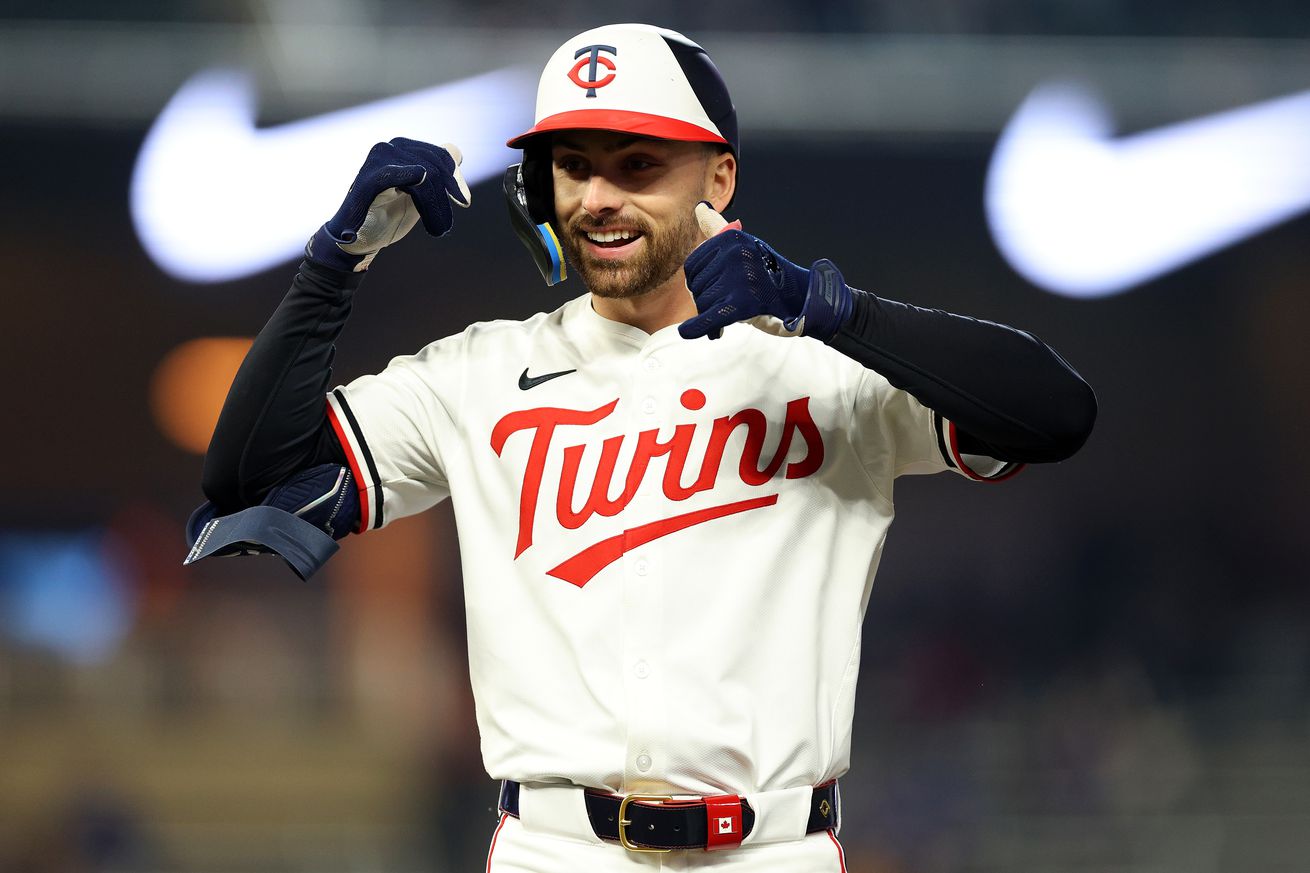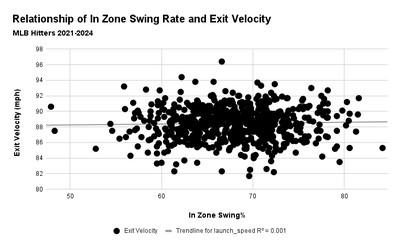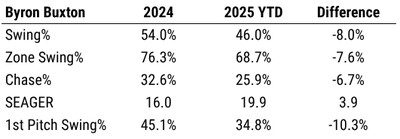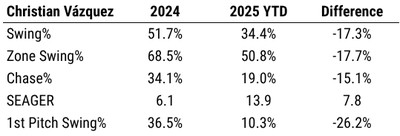
Who is going about their business at the plate in a different way?
We’ve spilled much internet ink talking about the Twins’ offense over the past few seasons. There was the ignominy of setting the record for strikeouts in a season in 2023. Then the inconsistency caused a feast or famine rollercoaster experience last season. That ultimately cost the hitting coach staff their positions with the team. Matt Borgschulte, a former hitting coach in the Twins’ minor league system, who had previously worked with many of the Twins’ young big leaguers, was brought back from Baltimore to lead the hitting staff in 2025.
It’s a long season, and a lot of randomness can occur over a 19-game sample. While a lot has gone wrong to have the Twins sitting at 7-12 through the middle of April, the collective (putrid) work of the offense is probably most to blame for the club’s slow start. As things stand today, the Twins are:
- 23rd in runs scored
- 25th in on-base percentage
- 25th in slugging percentage
- 24th in home runs
It wouldn’t be even close to fair to lay the early-season struggles at the feet of the new hitting coaches. Just as 19 games shouldn’t be enough to judge a hitter, neither should Borgschulte and company be evaluated based on a sample that size. It’s not even enough to know much about what they are emphasizing and trying to instill.
Regardless of the overall offensive struggles, we can examine which hitters might have changed their approaches at the dish. While the sample sizes are too small to draw meaningful conclusions from things like batted ball types and triple slash stats, we do have enough data to assess swing and decision-making, which are more or less under the hitter’s control.
Thinking About Approach
Before we do that, though, let’s do a quick detour through some of the latest analytic work on evaluating approaches at the plate.
When we talk about a hitter’s approach, perhaps the most common mainstream metric (and often the first one mentioned) is chase rate. Often, the next metric mentioned is in-zone swing rate. After all, we want hitters swinging at pitches in the strike zone and not chasing pitches all over the place. That’s the path to production. Right?
In practice, either stat individually isn’t particularly helpful. Chase rate tells us a lot about how well they avoid swinging at bad pitches, but tells us almost nothing about their ability to select pitches to attack and then do damage. Similarly, a hitter who swings at a lot of pitches in the zone might just swing at a lot of pitches.
When I plotted the relationship between hitter chase rate and weighted on-base average (wOBA) over the past four completed seasons, the data had an R^2 of .067. In other words, avoiding chases has little to do with offensive production.

Data from Baseball Savant
Similarly, swinging at pitches in the zone does not relate to hitting the ball harder. The relationship between in-zone swing rate and exit velocity in the same data set was an almost nonexistent R^2 = 0.001.

Data from Baseball Savant
The takeaway is that neither metric tells us much individually. But taken together, they can give us a better sense of a hitter’s approach. Twins fans who have lamented the contrasting extremes and one-dimensional approaches of José Miranda and Edouard Julien or who have been tormented by the Royals’ Salvador Perez hacking pitches from his ankles to his eyeballs into the Target Field bleachers should intuitively understand this.
Robert Orr built on this idea to introduce his method of evaluating hitter swing and take decision-making for Baseball Prospectus a couple of seasons ago. This method later became the basis for stats like PitcherList’s decision value, which I’ve referenced here before.
Orr’s new metric, which you should read about in the link above, is named SEAGER after Rangers’ shortstop Corey Seager — who is the living embodiment of this kind of pure “swing at what you can hit hard” approach — compares how often a hitter avoids going after pitches they can’t hit hard (selectivity) with how often they let hittable pitches pass by without a swing (hittable take).
The larger the difference between the two data points, the better the approach. Most importantly, Orr found that this method correlates well with stats like ISO and OPS and is more predictive of future production than chase rate and in-zone swing rate are by themselves.
With that explained, let’s look at four Twins who are showing adjusted (not necessarily better, but changed) approaches in early 2025.
Byron Buxton
The Twins centerfielder has never been a paragon of patience. His career walk rate is 6.6%, comfortably below the 8.4% league average. Buck likes to swing the bat. He’s offered at 50.8% of the pitches he’s seen in his career (league average = 47.2%) and chased 31.7% of pitches he’s seen out of the zone (league average = 28.5%).
So far in 2025, though, he’s toned back that swing aggressiveness:

Data from Baseball Savant and Robert Orr’s Leaderboard (Link)
If these changes hold all season, Buxton would have the lowest overall swing and chase rates of his career. His SEAGER score would be the second-best of his career, trailing only the 2022 season, when he cracked 28 homers in just 92 games and was 35% better than average offensively by wRC+.
Edouard Julien
Everyone’s favorite passive Canadian needed to make some adjustments to fight back against big league pitchers using his selective approach against him last season. Julien has come out much more aggressive so far in 2025:

Data from Baseball Savant and Robert Orr’s Leaderboard (Link)
Julien is taking a cut at significantly more pitches and is being much more aggressive early in counts and at pitches in the zone. He’s now swinging at slightly above league-average rates. Those extra swings have meant he’s chased out of the zone more often than we’re accustomed to seeing, and he’s only been drawing a walk at about half his usual rate. But, that’s traded against the fact that he’s cut his strikeout rate by about 9 points from last season.
The SEAGER metric doesn’t love these changes, but they are almost certainly purposeful after his passivity backfired so strongly last year. It will be interesting to watch if the aggression continues throughout the season, or if it was an early strategy to reset the opposing scouting reports and settle into a new equilibrium later.
Christian Vázquez
Even after adjusting for the demanding position he plays, Vázquez has been a poor offensive performer in a Minnesota uniform. Over 699 plate appearances since the start of the 2023 season, Vázquez has hit a combined .218/.261/.317 (.254 wOBA), which has been about 33 percent worse than the league average catcher by wRC+.
He’s done this with an approach that has had him swinging the bat at roughly league-average rates across all the categories we’re looking at here. Last season was especially aggressive for him, with the highest swing, first pitch swing, zone swing, and chase rates of his lengthy career:

Data from Baseball Savant and Robert Orr’s Leaderboard (Link)
This season, Vázquez has simply stopped swinging the bat, with massive reductions in aggression in every category. He now swings at a rate that is among the league’s least frequent, and each of these swing rate marks would be far and away the lowest of his career. That has meant he’s chased out of the zone significantly less often than in the past, which the SEAGER metric appears to like.
These changes have not had a noticeable effect on Vázquez’s overall numbers, and I have my doubts that they will. But, few good things have happened while he’s tried to swing it the past couple of seasons, so maybe keeping it on his shoulder instead of putting it in play is a strategy worth trying going forward. (That, and Rocco needs to have him sacrifice bunt almost every time he comes up with runners on base.)
José Miranda
Miranda’s early-season approach earned him yet another demotion to St. Paul, where he subsequently got strangely injured off the field. Miranda has plus contact ability, which has long proven to be his undoing at the plate. Just because you can hit it, doesn’t mean you should, and his expansive approach has led him to make too many outs on weak contact.
We can see that approach play out in this data, and it reveals a hitter who was twisted up and swinging at the ones he shouldn’t and taking the ones he should hit:

Data from Baseball Savant and Robert Orr’s Leaderboard (Link)
While Miranda’s overall swing rate isn’t that elevated from his career norms, his chase and zone swing rates tell the story. In the eyes of SEAGER, Miranda largely made good swing and take decisions last season, especially before he was hit in the head with a pitch, but those had fallen off the cliff this season. This tracks perfectly with Rocco Baldelli telling reporters after Miranda’s demotion, “I think he wants to do something so badly that he’s wanting to swing the bat before he knows what he’s swinging at.”
John writes for Twinkie Town, Twins Daily, and Pitcher List, with an emphasis on analysis. He is a lifelong Twins fan and former college pitcher.